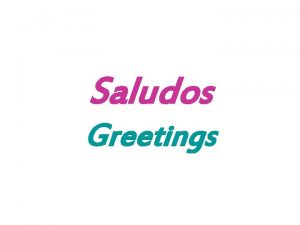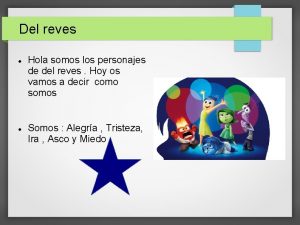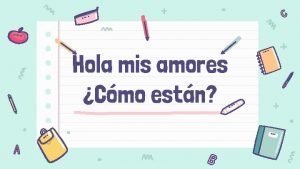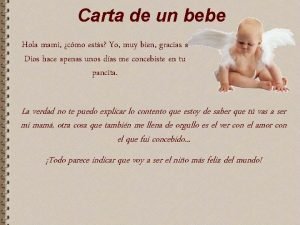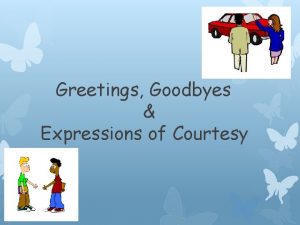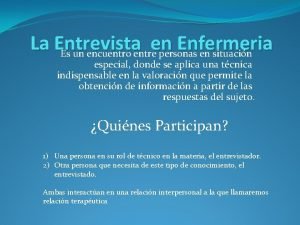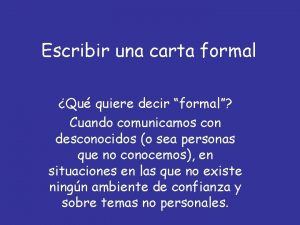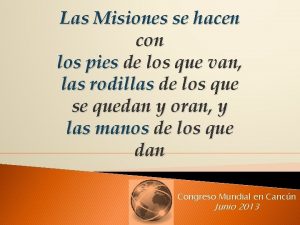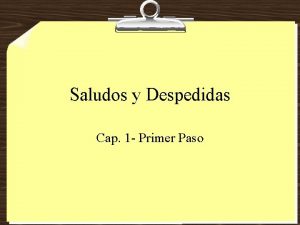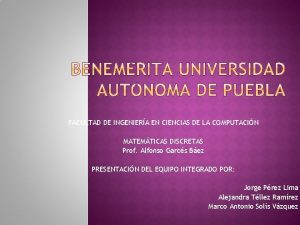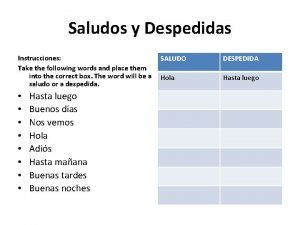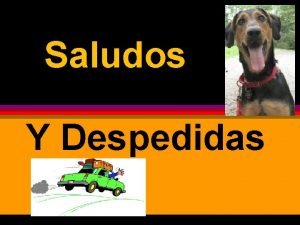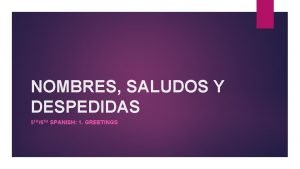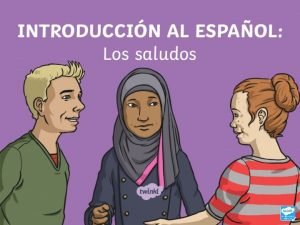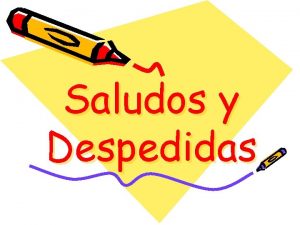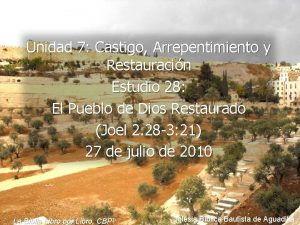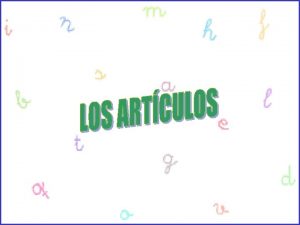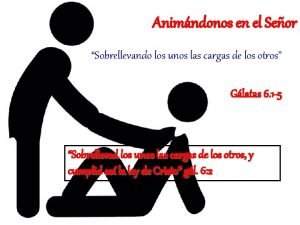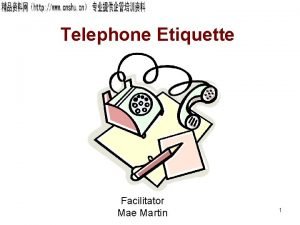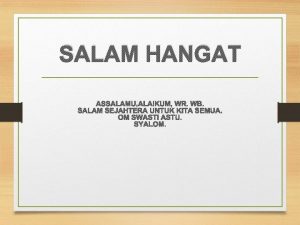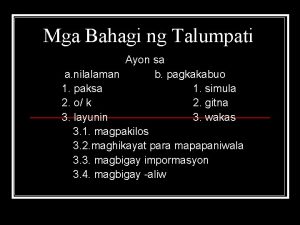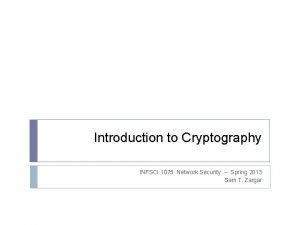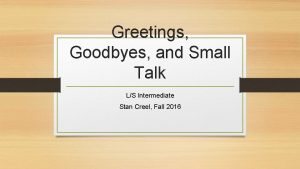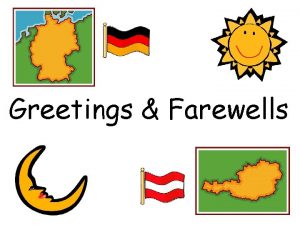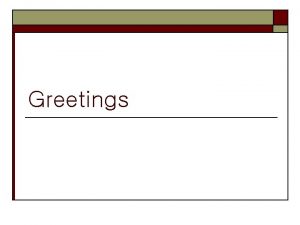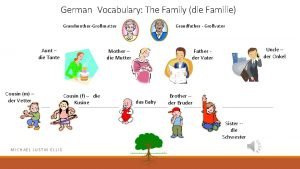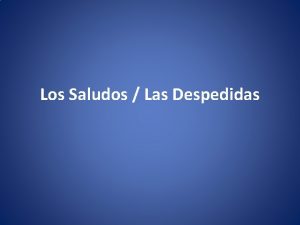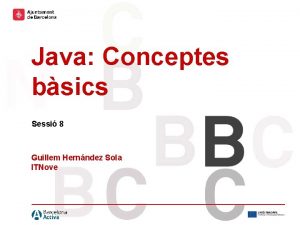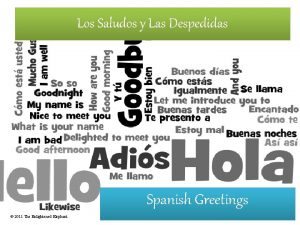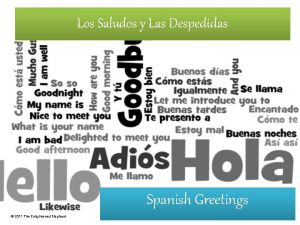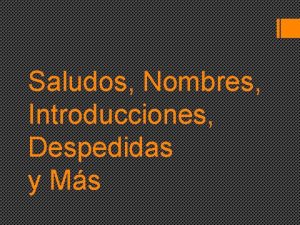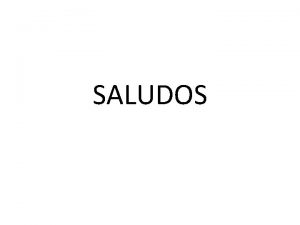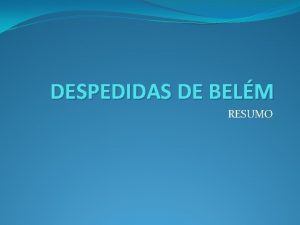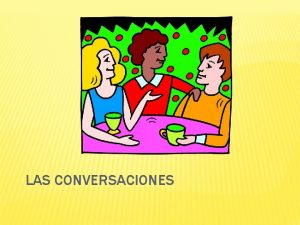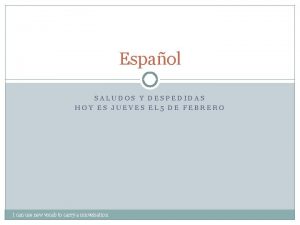Los Saludos y Las Despedidas Spanish Greetings Hola





















































- Slides: 53

Los Saludos y Las Despedidas Spanish Greetings

Hola

Buenos Días Good Morning!

Buenas Tardes Good Afternoon!

Buenas Noches Good evening/Goodnight!

One of these greetings was a little different than the others…. can you circle which one? Buenos días Buenas tardes Buenas noches

So why in the world is it buen. Os días with an O but buen. As tardes and buen. As noches with an A? ? ? the word días (day) is male so the words that describe it (bueno) must be male also, and O is a male ending…. . BUT the words tarde and noche are female so they must have female words with them and A is a female ending.

How would you greet (say hi to) Miguel at each time of day? (look at the clock for hints) Miguel




¡Bien Hecho! Now let’s learn how to ask how someone is doing!

¿Cómo estás? How are you?

If I was talking to the principal I would say ¿Cómo está Usted? . . . . can you guess why?

● In Spanish you have to show respect to people that are important or older than you. ● When you speak to them you must talk to them differently. ● This kind of talk is called “FORMAL”. ● So if you talk to anyone you use a title (Mr. , Mrs. Doctor, Representative, President) for then you need to speak to them in formal language. We will talk more about formal language later in this lesson

¿Qué tal? How’s it going?

¿Qué pasa? What’s up?

Estoy bien. I am well (good).

Estoy mal. I am bad (not good).

Estoy así-así. Estoy más o menos. I am so-so (ok, just alright).

Estoy regular. I’m doing average (same old) -you guys might say MEH

¿Y tú? And (how about) you?

¡Buen Trabajo! Now let’s practice what we’ve learned! ***What would you say if someone said the following things to you?

¿Qué tal? 1. Estoy mal. 2. ¿y tú? 3. Estoy bien 4. buenos días

Buenas tardes 1. Estoy así-así 2. Buenos días 3. Estoy bien 4. Buenas tardes

¿Cómo estás? 1. Estoy mal. 2. ¿y tú? 3. Estoy bien 4. buenos días

Hola 1. Estoy mal 2. Hola 3. Estoy bien 4. Buenos días

¡Excelente! Now let’s learn how to find out someone’s name and where they are from!

¿Cómo te llamas? What’s your name?

My name is… Me llamo Paco.

¿De dónde eres? Where are you from?

Soy de… I am from Arizona.

Mucho gusto. Nice to meet you.

El gusto es mío. The pleasure is mine.

Encantado/ Encantada. (I am) Delighted to meet you.

Can you guess why I (Sra. Bauman) would use encantad. A instead of encantad. O?

Igualmente. Likewise (me too/same here) =

¡Estupendo! Let’s practice using these phrases!!

If someone said the following phrase to you in Spanish how would you respond? Choose the best answer.

Mucho gusto

¿Cómo te llamas?

¿Cómo estás?

¿De dónde eres?

Me llamo Sara

¡Buen Trabajo! Now let’s learn how to say goodbye!

Hasta luego. See you later.

Hasta mañana. See you tomorrow.

Nos Vemos See ya! (peace out)

Adiós. Good-bye.

Wait! One more thing!

I mentioned FORMAL language earlier and said…. To show respect to someone, in Spanish you should speak to them formally. In general, speak formally with people: • you don’t know • older than you • In a superior position (like your boss, teacher or principal) • you would use a title with (Mr. , Mrs. , Dr. , Sir, President)

There are 2 things you need to change when using formal language: 1. the word “you” will be Usted instead of tú 2. The form of the verbs will be different Informal Questions Formal Questions ¿Cómo estás? ¿Cómo está? ¿Y tú? ¿Y Usted? ¿Cómo te llamas? ¿Cómo se llama? ¿De dónde eres? ¿De dónde es?

! jo n e u B ¡ a b a Tr El Fin ¡Bien Hech o!
 Nn ho
Nn ho 5 despedidas
5 despedidas Hola hola hola
Hola hola hola Hola means
Hola means Hola, buenas tardes
Hola, buenas tardes Hola buenos tardes
Hola buenos tardes Niño en kichua
Niño en kichua Hola
Hola Hola hola mis amores
Hola hola mis amores Hola mis amigas
Hola mis amigas Hola mami como estas
Hola mami como estas How to greet your dad's boss in spanish
How to greet your dad's boss in spanish Expressions of courtesy
Expressions of courtesy Despedidas para entrevistas
Despedidas para entrevistas Partes de una carta informal ejemplo
Partes de una carta informal ejemplo Estimada sra carta formal
Estimada sra carta formal Misiones se hacen con los pies delos que van
Misiones se hacen con los pies delos que van Primero saludos
Primero saludos Saludos sabado de gloria
Saludos sabado de gloria Jueves santo saludos
Jueves santo saludos A una reunion asisten 10 personas y se intercambian saludos
A una reunion asisten 10 personas y se intercambian saludos Saludos de buenos días buenas tardes buenas noches
Saludos de buenos días buenas tardes buenas noches Saludos de introduccion
Saludos de introduccion Nombres de saludos
Nombres de saludos Hola
Hola Saludos
Saludos Saludo de un informe
Saludo de un informe Hola linda que tal las clases
Hola linda que tal las clases Completa los dialogos hola que tal
Completa los dialogos hola que tal Polismica
Polismica Spanish 1 answer key
Spanish 1 answer key Las lenguas cesarán
Las lenguas cesarán Joel 2 29-32
Joel 2 29-32 Propio y comun
Propio y comun Animandonos los unos a los otros
Animandonos los unos a los otros Welcoming words for tourists
Welcoming words for tourists Ladies and gentlemen good morning
Ladies and gentlemen good morning Many greetings from
Many greetings from What is telephone etiquette
What is telephone etiquette Ask say tell
Ask say tell Warm.regards meaning
Warm.regards meaning Good evening ladies and gentlemen speech
Good evening ladies and gentlemen speech Ilan ang bahagi ng talumpati?
Ilan ang bahagi ng talumpati? Dear george greetings to all at oxford
Dear george greetings to all at oxford Not formal letter
Not formal letter Hi hi what are you doing
Hi hi what are you doing Apetii
Apetii Greetings farewells and small talk
Greetings farewells and small talk Hello good morning students
Hello good morning students Common greetings
Common greetings Different kinds of greetings
Different kinds of greetings Greetings from our lord jesus christ
Greetings from our lord jesus christ Teacher : good morning students
Teacher : good morning students German greetings and introductions
German greetings and introductions




